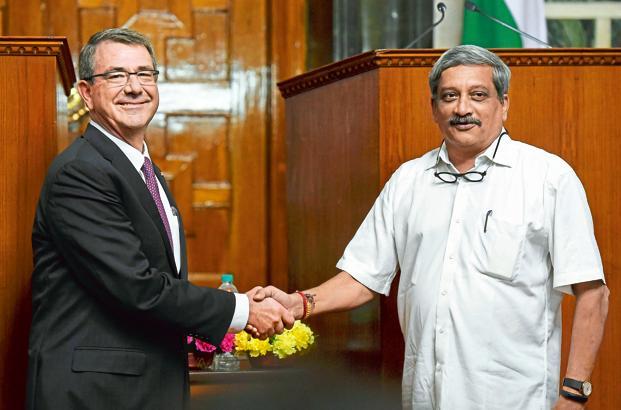By Gautam Mukherjee
- The Chinese thought India’s signing of the LEMOA (Logistics Exchange Memorandum of Agreement), with the United States was ‘troubles’. For whom, they did not say, but it is unlikely they meant themselves.
This agreement allows mutual access to military facilities for refuelling. LEMOA also allows for provisioning and replenishment of supplies, all on a reimbursable basis.
LEMOA does not automatically allow for military bases to be set up, and/or the stationing of troops, but these too can be authorised on a case-to-case basis.
It is the second agreement, out of four, for America’s defence partners. Two more are now under discussion. They are the CISMOA (Communications Interoperability & Security Memorandum of Agreement), and the BECA (Basic Exchange & Cooperation Agreement for Geo-Spatial Cooperation).
LEMOA comes after India was designated as a ‘Major Defence Partner’ during Prime Minister Narendra Modi’s state visit to the US in June 2016.
The first in the series, the GSOMIA (General Security of Military Information Agreement), was signed by the Vajpayee/Dubya Bush Governments, way back in 2002. Manmohan Singh’s UPA regimehad not moved forward at all on this strategic embrace during its decade in power.
For, India, LEMOA, its own $150 billion defence shopping list over the next 10 years, inclusive of Make in India, and its Modi Doctrine of ‘enlightened self-interest’, puts it in a unique position.
As for India’s tried and tested ties with Russia, there will be no downgrading it, and many military initiatives, in parallel, including some involving very high technology platforms, are indeed on the anvil. But yes, an edge of competition has entered the equation, and should work in India’s favour.
This has already been borne out in the nuclear power context, not only with Russia, but also with France, and the US — all supplying reactors, sometimes fuel, as well as know-how.
India will, in addition, cooperate with every major military power such as Britain and France on a bilateral basis. The list includes Israel, Sweden, Italy. It will also expand economic cooperation with many in the G-20, BRICS, other formations like ASEAN/APEC — including China.
This latest ‘troubles’ remark came, after the Chinese smirk on blocking our Nuclear Suppliers Group bid. Just as other Chinese commentators in a security establishment think-tank growled, when India positioned its supersonic BrahMos missiles, on its North Eastern border areas. Some also grumbled when India positioned over 100 tanks in Ladakh, not so long ago.
And again, when India raised the occupation/genocide/oppression, by the Pakistani state in Pakistan-occupied Kashmir and Balochistan. China and Pakistan have threatened to intervene in Balochistan, if need be.
With India being a nuclear weapons state too, the threat, if it comes to it, is of a multi-front conventional war, with Pakistan and China attacking in tandem.
India does not have the wherewithal to fight this simultaneoustwin threat to win on its own currently, but with a little help from America, it can, and will.
At this juncture of geo-political imperatives, a military alliance with America, therefore, acts as a great equaliser vis-à-vis China, and gives India time to build up its independent military capabilities.
Besides, America is not willing to give China a free passage to regional domination. Not any more than its NATO or ANZAC allies, or various other countries in South/Southeast Asia, including Japan, who are feeling the Chinese/North Korean overbite.
China will have to realise that it is deeply isolated, with only a couple of unstable rogue states in the form of Pakistan and North Korea for company.
China’s old ‘string of pearls’ strategy of encirclement of India via economic and infrastructural participation in Myanmar, Bangladesh, Sri Lanka, Afghanistan, Nepal, the Maldives, Bhutan etc. now lies in ruins.
Chinese President Xi Jinping’s Albert Speerish ‘belt and road’ initiative, figuratively girding the world as a super Silk Route, also makes everyone approached uncomfortable, including communities of people in Gilgit-Baltistan and Balochistan, where the proposed China-Pakistan Economic Corridor (CPEC) is part of it.
But apart from the hawkish posturing, China too is keen to advance economic cooperation with India — in manufacturing, infrastructure (particularly in Indian Railways), and trade. It is necessary for China to resolve its aggressive tendencies though, because India is no longer willing to be intimidated, and has a number of options.
China, however, is most impressed with its own sizeable military. It wants the world to fear its conventional and nuclear might.
It wants to dominate its half the world, ignoring the wishes of others in its littoral. It does not accept the International Court of Justice at the Hague’s verdict on the South China Sea, and still wants sea exclusively for itself, ignoring Vietnam and the Philippines in the process.
It wants to dominate the Indian Ocean too, and has been patrolling it vigorously in recent years.
China’s notions on diplomacy also emboldens it to ignore the wishes of the other members of the UNSC, thinking being factory to 40% of the world’s manufactured goods is enough leverage.
That the ancient, but newly prosperous Chinese, do not understand the implications of trying to game the much more powerful America, seems amply clear.
America has a military 17 times bigger than the next power, and China is not it! So, for India, a defence pact with America at this juncture is most comforting, enabling it to deal fairly with the rest of the world without security worries.
(The writer is a senior commentator)
(The views expressed are the author's own and do not necessarily reflect the position of the organisation)

